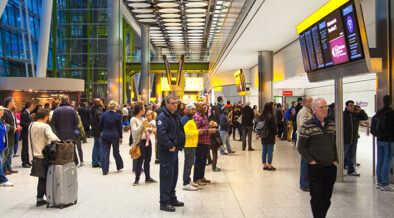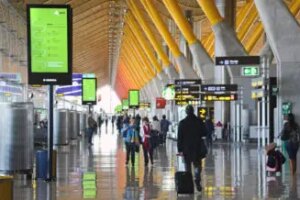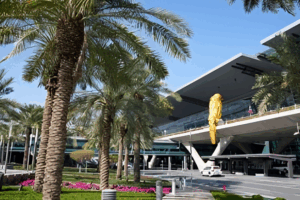
Utilising intelligent video technology can help enhance safety, security and operational efficiency at airports, especially during busy peak periods, writes Milestone Systems’ Martin McGrath.
With the busy summer rush rapidly approaching in the Northern Hemisphere, and following numerous high profile operational challenges in airports around Europe since the pandemic, airport managers will be developing watertight plans to cope with every eventuality.
Safety, security and efficiency remain at the top of the agenda, but each is amplified by the pressures of high volumes of traffic, poor weather, and seasonal employee challenges.
As global air traffic volumes keep climbing towards pre-pandemic heights, it’s important that the technology that protects airports keeps pace.
One technology solution not to be overlooked is video, which – when combined with artificial intelligence (AI) – offers a high-impact way to mitigate risks, streamline operations, enhance emergency response times, and improve the overall passenger experience.
By harnessing the power of the extensive existing video systems in airports, we can transform the way we approach operations during busy times and help improve customer experience and public perception. Smarter video solutions are an easy add-on that can help make modern airport management significantly easier.
Using video technology to support smoother operations
It might seem strange to some to say it, but video technology really is a secret weapon in the drive for smoother airport operations.
Why? Because the use of smart cameras means that tech systems can process and present huge volumes of data to security and facilities teams, allowing them to monitor events in real time and make informed and proactive decisions in the moment.
Indeed, there are many ways in which this can translate to on the ground operations ranging from queue management, security support, staffing levels and accommodating kerbside traffic.
– Queue management. Software can be trained to predict queues and bottlenecks based on crowd behaviour, allowing earlier intervention to avoid queues from forming, for example by opening more check in desks or security scanners.
– Security support. The use of AI has a role to play in supporting security, with cameras able to recognise specific behaviour patterns and flag them for human review instantly.
– Peaks and troughs. Footfall peaks and troughs are, of course, linked to flight times, but camera systems can help provide the data to inform staff throughout the airport from check in through to departures.
– Kerbside traffic. Kerbside traffic at arrivals and departures can be improved by using technology to support with everything from number plate recognition and dwell time to managing taxi and lift-share services.
By integrating video data with other airport systems including access control, baggage handling and retail delivers a holistic view of an airport’s operations, enabling better automation and offering the opportunity for reduced manual errors.

How technology is already in use
There are numerous global examples of where airports have used cloud-integrated video technology software to support operations.
In Brazil, for instance, a major airport serving over 15 million passengers a year upgraded its systems during a cloud first initiative and now manages over 1,000 cameras, with video data retained for 200 days.
Live monitoring and playback alike are serving the airport well and enhancing its emergency response approach with instant access to critical video data, significantly improving the airport’s ability to respond swiftly and effectively to emergency situations.
At another airport in Argentina, around 800 cameras support the security team with a mix of high-resolution cameras, pan/tilt/zoom systems, and thermal imaging cameras.
In this airport, a virtual perimeter defence software helps keep secure areas safe, automatically detecting motion and issuing alerts when activity is detected in areas where it shouldn’t be.
Video management software also helps support small airports. At Jackson Hole Airport in Wyoming, USA, for example, more than 220 cameras support with everything from monitoring security checkpoints and baggage areas to keeping an ice on plane de-icing away from the terminal.
With a relatively small staff, video can help with footfall management and flagging people crossing into restricted areas or moving against foot traffic flow.
Harnessing the power of the cloud
The changes in cloud connectivity in recent years means that working with cloud or hybrid solutions is second nature.
When it comes to using video tech to support operations, this is great news, because it means that systems can be integrated easily and painlessly. Using a cloud solution – rather than managing video data in an on-premises system – opens up greater possibilities for airport managers.
In essence, cloud options provide more flexibility and scalability and are simple to install.
Cloud solutions work well for airports of all sizes thanks to their ability to flex and scale depending on requirements.
This not only means they are adaptable by size but also by season and busier periods like summer or end of year travel as they can be quickly scaled up.
Keeping an eye on compliance
Regulations, governance and security compliance all have a hand in video data management, so it’s important to ensure that any video solution meets the stringent regulatory landscape around data handling.
When working with supplier partners, it’s important to ask them about their data handling and ensure that these integrate with your own policies and procedures.
As technology becomes even smarter, airports will benefit from increased automation and ways to augment human decision-making. Ensuring compliance forms a key part of this and is essential for airports that want to grow sustainably and continue to provide excellent service.
A look to the future
Modern airport management is changing, but seasonal peaks in people flow remain a constant.
As we head into one of the busiest times of year for travel in the Northern Hemisphere, there’s a great opportunity for airport leaders to look critically at their operational management systems and consider how technology can play a greater role.
The cost of inaction is far greater than the cost of investment into the technology infrastructure that will enable the airport management of tomorrow.
About the author
Martin McGrath is the sales manager for UK & Ireland at Milestone Systems.






